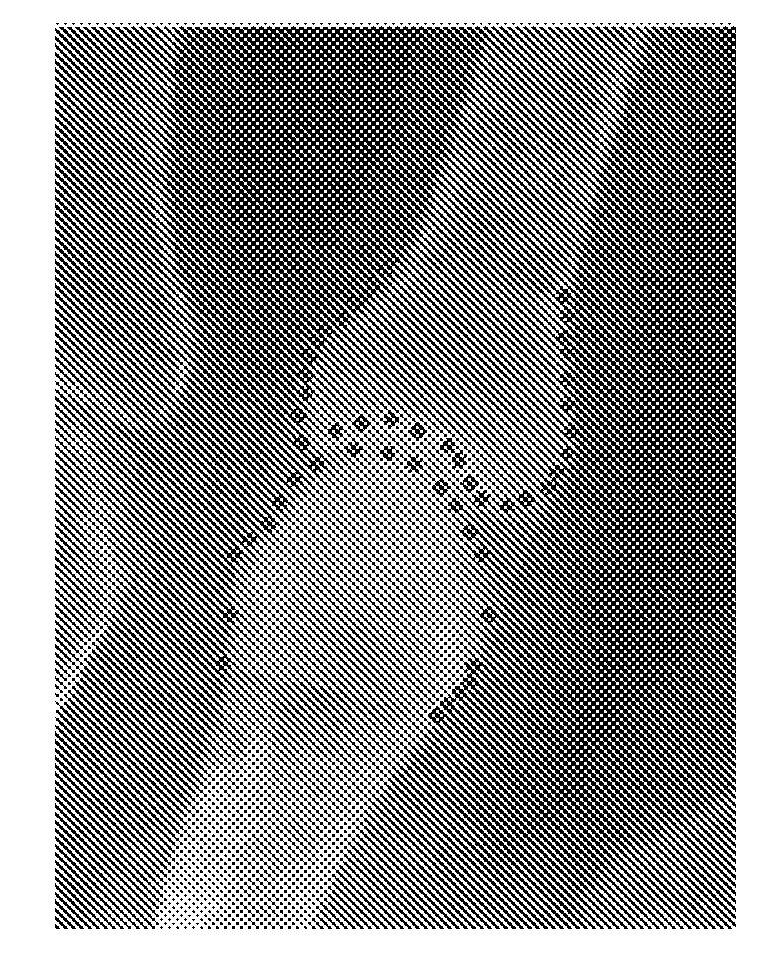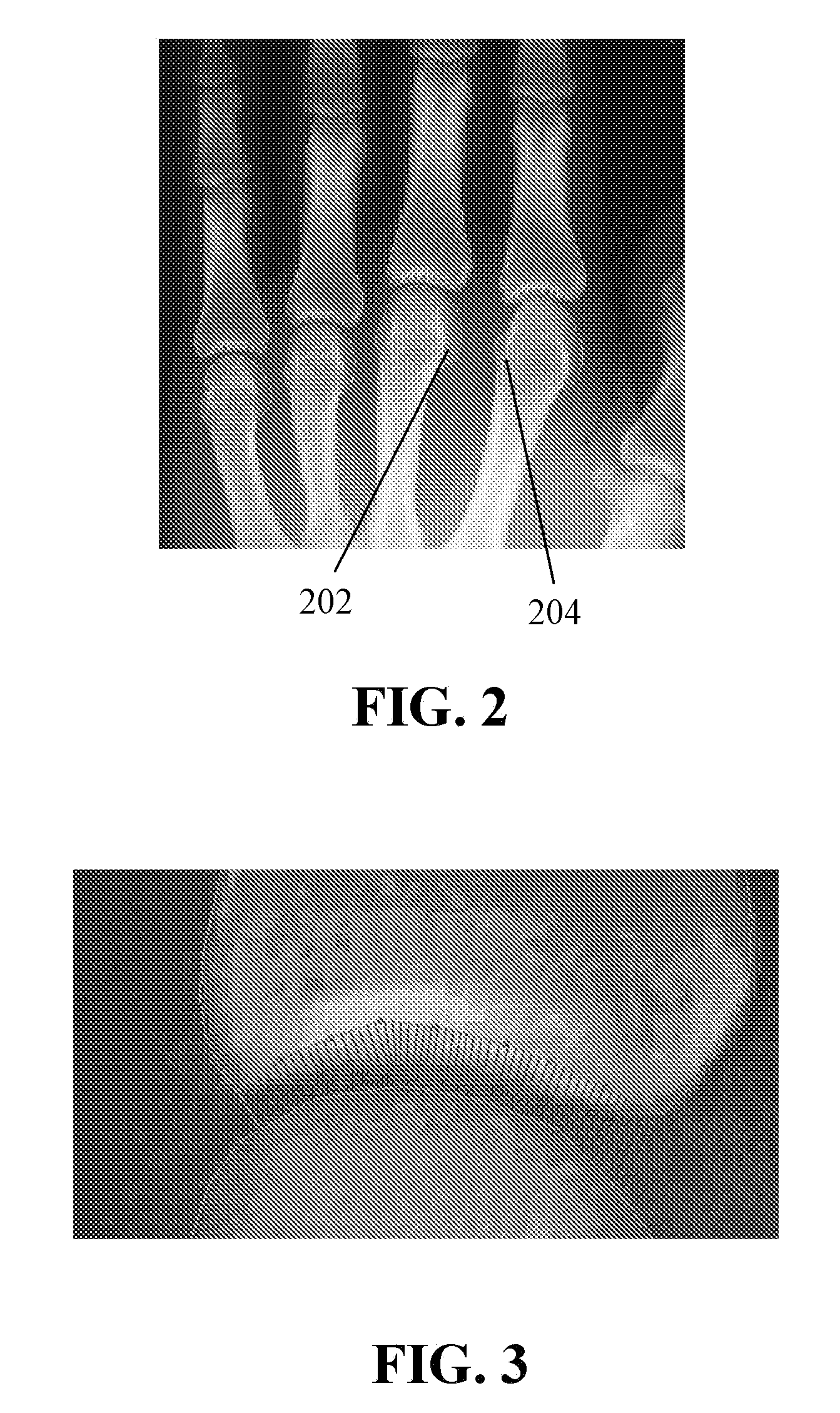[0020]Methods for producing an image indicative of arthritic symptomatology are provided. The methods during a model building phase create a constrained deformable statistical template that is characterized by a set of parameters that spans a vector space representing a set of spatial positions of specified features of a specified joint. Each vector in the vector space describes a unique variation from a population mean. Creating the statistical template comprises building a statistical template from a set of sample radiographs of a skeletal system that includes at least the specified joint. The set of sample radiographs is chosen to substantially exclude pathological variations of a specified joint to represent variations in radiographic shape and appearance. The methods then during a runtime phase fit, in a digitized target two-dimensional radiograph of the specified joint, a plurality of loci associated with the specified features of the specified joint to allow parameterization in terms of the statistical template, wherein the digitized target radiograph may have traces of erosions. The methods next during the runtime phase parameterize positions of the plurality of loci fitted in the digitized target radiograph to generate an instance of the statistical template by deriving values for parameters of the digitized target radiograph from the statistical template. The methods next during the runtime phase search the digitized target radiograph by applying the statistical template to the digitized target radiograph until an optimal fit of the statistical template to at least one region of the digitized target radiograph is found, wherein searching the digitized target radiograph for the optimal fit comprises adjusting the position, orientation, shape and texture of the statistical template until the differences between the statistical template and the at least one region of the digitized target radiograph are minimized. The methods next during the runtime phase produce a comparison image by comparing the at least one region of the digitized target radiograph with the optimal fit of the statistical template.
[0021]Methods for deriving measures indicative of arthritic symptomatology are provided. The methods during a model building phase create a constrained deformable statistical template that is characterized by a set of parameters that spans a vector space representing a set of spatial positions of specified features of a specified joint. Each vector in the vector space describes a unique variation from a population mean. Creating the statistical template comprises building a statistical template from a set of sample radiographs of a skeletal system that includes at least the specified joint. The set of sample radiographs is chosen substantially exclude pathological variations of a specified joint to represent variations in radiographic shape and appearance. The methods then during a runtime phase fit, in a digitized target two-dimensional radiograph of the specified joint, a plurality of loci associated with the specified features of the specified joint to allow parameterization in terms of the statistical template, wherein the digitized target radiograph may have traces of erosions. The methods next during the runtime phase parameterize positions of the plurality of loci fitted in the digitized target radiograph to generate an instance of the statistical template by deriving values for parameters of the digitized target radiograph from the statistical template. The methods next during the runtime phase search the digitized target radiograph by applying the statistical template to the digitized target radiograph until an optimal fit of the statistical template to at least one region of the digitized target radiograph is found, wherein searching the digitized target radiograph for the optimal fit comprises adjusting the position, orientation, shape and texture of the statistical template until the differences between the statistical template and the at least one region of the digitized target radiograph are minimized. The methods next during the runtime phase derive at least one measure indicative of arthritic symptomatology of said specified joint by comparing the at least one region of the digitized target radiograph with the optimal fit of the statistical template.
[0022]Methods are provided. The methods during a model building phase create a constrained deformable statistical template that is characterized by a set of parameters that spans a vector space representing a set of spatial positions of specified features of a specified joint. Each vector in the vector space describes a unique variation from a population mean. Creating the statistical template comprises building a statistical template from a set of sample radiographs of a skeletal system that includes at least the specified joint. The set of sample radiographs is chosen to substantially exclude pathological variations of a specified joint to represent variations in radiographic shape and appearance. The methods then during a runtime phase fit, in a first digitized target two-dimensional radiograph of the specified joint, a plurality of loci associated with the specified features of the specified joint to allow parameterization in terms of the statistical template, wherein the first digitized target radiograph may have traces of erosions. The methods next during the runtime phase parameterize positions of the plurality of loci fitted in the first digitized target radiograph to generate an instance of the statistical template by deriving values for parameters of the first digitized target radiograph from the statistical template. The methods next during the runtime phase search the first digitized target radiograph by applying the statistical template to the first digitized target radiograph until a first optimal fit of the statistical template to at least one region of the first digitized target radiograph is found, wherein searching the first digitized target radiograph for the first optimal fit comprises adjusting the position, orientation, shape and texture of the statistical template until the differences between the statistical template and the at least one region of the first digitized target radiograph are minimized. The methods next during the runtime phase repeat steps of fitting, parameterizing, and searching for a second digitized target two-dimensional radiograph of said specified joint obtained at a second time to find a second optimal fit of said statistical template to at least one region of said second digitized target radiograph. The methods next during the runtime phase derive at least one measure indicative of the progression of arthritic symptomatology of said specified joint by comparing said first optimal fit of said statistical template and said second optimal fit of said statistical template.
[0023]Computer program products for producing an image indicative of arthritic symptomatology are provided, comprising a constrained deformable statistical template and computer program codes for receiving a digitized input target radiograph and generating an optimal fit of the statistical template to the digitized target radiograph. The statistical template is characterized by a set of parameters that spans a vector space representing a set of spatial positions of specified features of a specified joint. Each vector in the vector space describes a unique variation from a population mean, wherein the statistical template is built from a set of sample radiographs of a skeletal system that includes at least the specified joint. The set of sample radiographs is chosen substantially exclude pathological variations of a specified joint to represent variations in radiographic shape and appearance. The computer program products includes: code for fitting, in a digitized target two-dimensional radiograph of the specified joint, a plurality of loci associated with the specified features of the specified joint to allow parameterization in terms of the statistical template, wherein the digitized target radiograph may have traces of erosions; code for parameterizing positions of the plurality of loci fitted in the digitized target radiograph to generate an instance of the statistical template by deriving values for parameters of the digitized target radiograph from the statistical template; code for searching the digitized target radiograph by applying the statistical template to the digitized target radiograph until an optimal fit of the statistical template to at least one region of the digitized target radiograph is found, wherein searching the digitized target radiograph for the optimal fit comprises adjusting the position, orientation, shape and texture of the statistical template until the differences between the statistical template and the at least one region of the digitized target radiograph are minimized; and code for producing a comparison image by comparing the at least one region of the digitized target radiograph with the optimal fit of the statistical template.
[0024]Computer program products for producing an image indicative of arthritic symptomatology are provided, comprising a constrained deformable statistical template and computer program codes for receiving a digitized input target radiograph and generating an optimal fit of the statistical template to the digitized target radiograph. The statistical template is characterized by a set of parameters that spans a vector space representing a set of spatial positions of specified features of a specified joint. Each vector in the vector space describes a unique variation from a population mean, wherein the statistical template is built from a set of sample radiographs of a skeletal system that includes at least the specified joint. The set of sample radiographs is chosen to substantially exclude pathological variations of a specified joint to represent variations in radiographic shape and appearance. The computer program products includes: code for fitting, in a digitized target two-dimensional radiograph of the specified joint, a plurality of loci associated with the specified features of the specified joint to allow parameterization in terms of the statistical template, wherein the digitized target radiograph may have traces of erosions; code for parameterizing positions of the plurality of loci fitted in the digitized target radiograph to generate an instance of the statistical template by deriving values for parameters of the digitized target radiograph from the statistical template; code for searching the digitized target radiograph by applying the statistical template to the digitized target radiograph until an optimal fit of the statistical template to at least one region of the digitized target radiograph is found, wherein searching the digitized target radiograph for the optimal fit comprises adjusting the position, orientation, shape and texture of the statistical template until the differences between the statistical template and the at least one region of the digitized target radiograph are minimized; and code for deriving at least one measure indicative of arthritic symptomatology by comparing the at least one region of the digitized target radiograph with the optimal fit of the statistical template.
 Login to View More
Login to View More  Login to View More
Login to View More 


